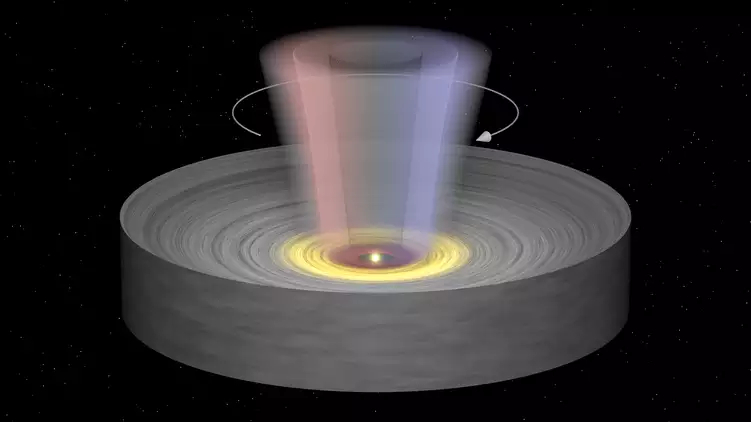A star is born! How cosmic winds are a key step in stellar formation
The flow of matter around a young star could prevent stars from being ripped apart as they form.

Astronomers have discovered an important step in star formation, hitherto unknown, that could save infant stars from ripping themselves apart. The rescue mechanism is associated with "cosmic winds" that blow around clouds of gas and dust — and it's these clouds that eventually collapse to form hot and dense stellar bodies. Plus, the clouds manage to slow these forming stars' spins.
A team of scientists, led by researchers from the Max Planck Institute for Astronomy arrived at this conclusion by making radio wave observations of a young star in a dark cosmic cloud called CB26; it's located around 460 light-years from Earth. They then combined these observations with a variety of analysis techniques, and ultimately, modeled the flow of matter around CB26.
The findings may have revealed how some stars form in collapsing gas clouds without their own angular momentum and rotation tearing them apart.
Related: Star-studded stellar nursery shines in new Hubble Telescope photo
Infant stars are their own worst enemies
Stars are born when overly dense regions of cosmic clouds collapse under the influence of their own gravity. These clouds are comprised of mostly hydrogen with some helium and a smattering of heavier elements — the latter of which astronomers call "metals." And when the clouds reach a certain density and temperature as a result of this collapse, a process known as nuclear fusion gets triggered within. That fusion mechanism converts the clouds' hydrogen atoms to helium atoms, forms a vast amount of energy, and thus, a star is born.
An underlying problem in this story, however, is that gas clouds rotate as a result of possessing angular momentum — and physics says angular momentum must be conserved. This is coupled with the fact that the cloud's shrinking diameter (as it turns into an orb-like star) means it would rotate more rapidly over time. You can think of it as the cosmic equivalent of an ice skater drawing in their arms to spin faster.
Spinning faster also generates more intense centrifugal forces, moving matter away from the axis of rotation which sits at the center of the forming star effectively tearing them apart. This could be fatal for an infant star — or "protostar" — if enough material is flung out from the center of the collapsing cloud and there isn’t enough left to trigger nuclear fusion.
Breaking space news, the latest updates on rocket launches, skywatching events and more!
Astronomers call this dilemma the angular momentum problem of star formation.
The answer is blowing in the wind
One possible solution for this issue, scientists think, has to do with matter falling to the central region of a collapsing cloud. Potentially, that matter forms an accretion disk of gas and dust around the protostar, providing it with additional matter needed to trigger nuclear fusion if some material got lost during the whole fast-spinning situation.
Accretion disks could also help carry angular momentum away from protostars. This would happen because, as the hydrogen gas in the accretion gas spins, it gets heated. From there, electrons are stripped away from protons, creating a sea of charged particles called plasma. The movement of these particles creates a magnetic field in the accretion disk, which, in turn, influences the flow of the plasma; some of the plasma even drifts away across magnetic field lines. These runaway blobs of plasma may eventually collide with electrically neutral matter, and carry the matter away in a "disk wind" that also carries some of the matter's angular momentum.
That loss of angular momentum starts to put the brakes on the spin of the central protostar, experts believe, lessening centrifugal forces and possibly solving the angular momentum problem. But what this plausible hypothesis has lacked until now was observational evidence.
This is partially because, from our perspective on Earth, an accretion disk around even a budding local star is extremely small.
Then, after 20 years of astronomers hunting for such evidence, in 2009, Launhardt and colleagues managed to observe the outflow of material around a young star in CB26 — one of the closest known disk systems around a protostar The observations were made with an array of antennas called the Plateau de Bure Interferometer, which together act as a single, massive radio telescope capable of detecting emission characteristics of even individual molecules. Focusing on carbon monoxide emissions, the team saw the changing of light indicative of motion away from Earth — the stretching of wavelengths called redshift — and the compression of wavelengths toward Earth — blueshift.
This showed that the gas in this accretion disk demonstrates the kind of motion characteristic of a rotating "disk wind" of molecules carrying away angular momentum — emerging from the disk like a twisting tornado. What Launhardt and colleagues couldn’t determine from this set of measurements in 2009, though, was how far away the wind carried matter from the central young star. That bit is key to understanding if the wind could be removing enough angular momentum from the forming star to truly prevent it from being shredded up.
In this new research, Launhardt and his team conducted further observations of the accretion disk system and its protostar in much higher resolution. That was achieved by configuring the Plateau de Bure observatory radio antennas to be much farther apart than they were during the team’s first observations. The researchers also applied a sophisticated modeling scheme to distinguish between contributions of matter from the disk and material coming from the disk wind.
This let them measure the dimensions of the conical-shaped outflow of matter near the disk for the first time; they found the diameter at the outflow’s base was around 3 times the distance between Earth and Neptune. That's about 8.1 billion miles. What this means is the disk wind is more than wide enough to carry away a significant amount of angular momentum — and is thus capable of protecting protostars from ripping themselves apart.
The team now intends to investigate this protostar in CB26, possibly using the upgraded Plateau de Bure Interferometer. The observatory has since been renamed Noema and has a doubled antenna count of 12.
The team’s research was published on Oct. 17 in the journal Astronomy and Astrophysics.

Robert Lea is a science journalist in the U.K. whose articles have been published in Physics World, New Scientist, Astronomy Magazine, All About Space, Newsweek and ZME Science. He also writes about science communication for Elsevier and the European Journal of Physics. Rob holds a bachelor of science degree in physics and astronomy from the U.K.’s Open University. Follow him on Twitter @sciencef1rst.
